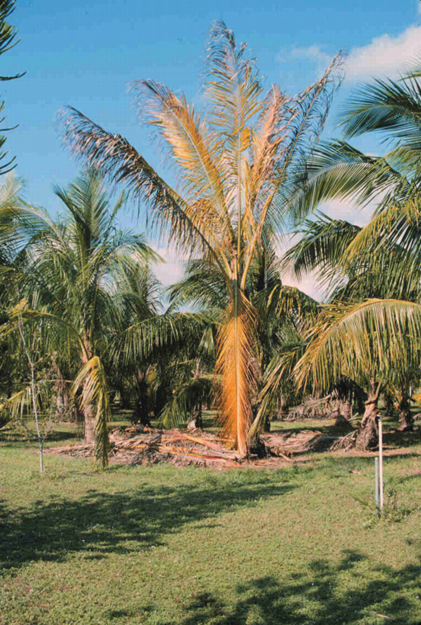Phytoplasma Diseases of Palms in the USA
Robert R Krueger1 and Brian W Bahder2
1USDA-ARS National Clonal Germplasm Repository for Citrus & Date, Riverside, CA
2Dept of Entomology & Nematology, University of Florida Fort Lauderdale Research & Education Center, Davie, FL
Phytoplasmas are plant pathogenic bacteria that lack cell walls and have reduced genomes. Their taxonomy has historically been based upon 16S ribosomal gene sequences. Since they have not been cultured to date, they are classified as Candidatus Phytoplasma spp. Phytoplasmas of various taxonomic designations have been associated with or shown to cause diseases in a wide range of cultivated and wild plant species. In recent years, long-established and newly reported declines or diseases of palms have been associated with phytoplasmas. Although there are reports of phytoplasma-associated diseases of palms in both the Eastern and Western Hemispheres, this brief review will focus on reports from the United States.
The earliest reported disease of palms that was later associated with Phytoplasma infection was Lethal Yellows (LY). LY is a disease which attacks and kills coconut palms (Cocos nucifera). LY was first reported in Jamaica in 1891 and much later (1972) associated with a phytoplasma (Tsai and Harrison 2003), which was later identified as being in the taxonomic sub-group 16SrIV-A (Harrrison et al. 2002a). An epiphytotic of LY occurred in southern Florida in the 1960's to 1970's (Tsai and Harrison 2003). During this outbreak Phoenix spp., which in Florida were planted as ornamentals or present in germplasm collections or botanic gardens were also shown to be susceptible. This was evidenced by the presence of mycoplasma-like bodies observed in tissues via electron microscopy (Thomas 1974, 1979; Howard et al. 1979). Phoenix dacytlifera was more susceptible to decline than other Phoenix spp., being equivalent in this regard to C. nucifera (Howard and Barrant 1989), although the symptomology was distinct compared to that in C. nucifera (McCoy et al. 1983). The vector of LY in Coconut palm was demonstrated to be the planthopper Haplaxius crudus van Duzee, and this was assumed to be the vector transmitting LY to Phoenix spp. as well (Howard et al. 1983, 1984).
There's a lot more to this story: https://ceventura.ucanr.edu/Com_Ag/Subtropical/?newsletteritem=100493
Foliar yellowing symptoms of Lethal Yellows on Coconut palm. Photo credit: NA Harrison
